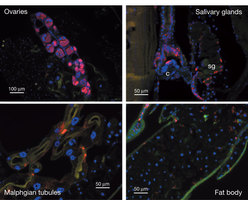登革热是一种主要由埃及伊蚊传播的病毒性传染病,儿童患者死亡率较高,如何控制登革热传播是一个世界性难题。澳大利亚和美国研究人员8月24日表示,这一难题或许可借助沃尔巴克氏菌来解决,这种细菌可阻止登革热病毒在蚊子体内复制增殖。
自然界中约28%的蚊子体内天然携带共生菌——沃尔巴克氏菌,不过埃及伊蚊不在其列。澳大利亚墨尔本大学、美国加州大学戴维斯分校等机构的研究人员在澳大利亚北部某实验区释放了一批染有沃尔巴克氏菌的蚊子。染菌的雄蚊与未感染的雌蚊交配后,雌蚊根本不产卵。而染菌的雌蚊交配后仍可产卵,并能把沃尔巴克氏菌传给后代。从理论上讲,这种趋势会使染有沃尔巴克氏菌的蚊子越来越多,未感染该细菌的蚊子日益减少,从而抑制登革热传播。据研究人员介绍,目前沃尔巴克氏菌正在实验区的野生蚊子种群中迅速传播,预计埃及伊蚊也会被感染。
这项研究成果将于25日发表在新一期英国《自然》杂志上。美国盖茨基金会已表示将进一步提供资助,支持在澳大利亚、越南和泰国释放感染沃尔巴克氏菌的蚊子。
美国密歇根州立大学助理教授奚志勇2010年4月也曾报告说,他和同事开发了用沃尔巴克氏菌阻止登革热传播的方法。奚志勇当时接受新华社记者采访时说,澳大利亚研究人员也进行了类似研究,不同之处在于两项研究利用的沃尔巴克氏菌菌株不同。
奚志勇指出,澳大利亚研究人员利用的菌株可以减少蚊子寿命,其有利之处在于可直接减少蚊子向人类传播登革热的几率,不足之处在于细菌扩散到整个蚊子种群中的速度会降低。据奚志勇介绍,他们的研究可以延长蚊子的寿命,使被沃尔巴克氏菌感染的蚊子在整个生命周期繁育更多携带该细菌的后代,从而尽快将细菌扩散至整个种群。两种方法可谓殊途同归,均表明可以直接利用沃尔巴克氏菌遏制登革热传播。
生物探索推荐英文论文摘要:
The wMel Wolbachia strain blocks dengue and invades caged Aedes aegypti populations
Dengue fever is the most important mosquito-borne viral disease of humans with more than 50 million cases estimated annually in more than 100 countries. Disturbingly, the geographic range of dengue is currently expanding and the severity of outbreaks is increasing. Control options for dengue are very limited and currently focus on reducing population abundance of the major mosquito vector, Aedes aegypti. These strategies are failing to reduce dengue incidence in tropical communities and there is an urgent need for effective alternatives. It has been proposed that endosymbiotic bacterial Wolbachia infections of insects might be used in novel strategies for dengue control. For example, the wMelPop-CLA Wolbachia strain reduces the lifespan of adult A. aegypti mosquitoes in stably transinfected lines. This life-shortening phenotype was predicted to reduce the potential for dengue transmission. The recent discovery that several Wolbachia infections, including wMelPop-CLA, can also directly influence the susceptibility of insects to infection with a range of insect and human pathogens has markedly changed the potential for Wolbachia infections to control human diseases. Here we describe the successful transinfection of A. aegypti with the avirulent wMel strain of Wolbachia, which induces the reproductive phenotype cytoplasmic incompatibility with minimal apparent fitness costs and high maternal transmission, providing optimal phenotypic effects for invasion. Under semi-field conditions, the wMel strain increased from an initial starting frequency of 0.65 to near fixation within a few generations, invading A. aegypti populations at an accelerated rate relative to trials with the wMelPop-CLA strain. We also show that wMel and wMelPop-CLA strains block transmission of dengue serotype 2 (DENV-2) in A. aegypti, forming the basis of a practical approach to dengue suppression.

Figure 1: Tissue distribution of the wMel strain in transinfected A. aegypti female mosquitoes.







